Australopithecus afarensis
| Australopithecus afarensis | |
|---|---|
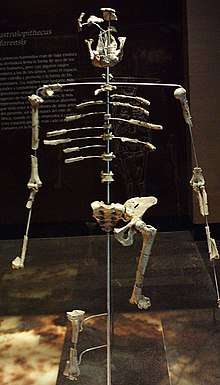 | |
| A replica of the remains of Lucy, Museo Nacional de Antropología, Mexico City | |
| Scientific classification | |
| Kingdom: | Animalia |
| Phylum: | Chordata |
| Class: | Mammalia |
| Order: | Primates |
| Suborder: | Haplorhini |
| Infraorder: | Simiiformes |
| Family: | Hominidae |
| Subfamily: | Homininae |
| Tribe: | Hominini |
| Genus: | Australopithecus |
| Species: | †A. afarensis |
| Binomial name | |
| Australopithecus afarensis | |
| Synonyms[2] | |
| |
Australopithecus afarensis (Latin: "Southern ape from Afar") is an extinct hominin that lived between 3.9 and 2.9 million years ago [3] in Africa.[4][5][6] A. afarensis was slenderly built, like the younger Australopithecus africanus. A. afarensis is thought to be more closely related to the genus Homo (which includes the modern human species Homo sapiens), whether as a direct ancestor or a close relative of an unknown ancestor, than any other known primate from the same time.[7] Some researchers include A. afarensis in the genus Praeanthropus.[8]
The most famous fossil is the partial skeleton named Lucy (3.2 million years old) found by Donald Johanson and colleagues, who, in celebration of their find, repeatedly played the Beatles song "Lucy in the Sky with Diamonds".[9][10][11]
Localities
Australopithecus afarensis fossils have only been discovered within Eastern Africa. Despite Laetoli being the type locality for A. afarensis, the most extensive remains assigned to the species are found in Hadar, Afar Region of Ethiopia, including the above-mentioned "Lucy" partial skeleton and the "First Family" found at the AL 333 locality. Other localities bearing A. afarensis remains include Omo, Maka, Fejej, and Belohdelie in Ethiopia, and Koobi Fora and Lothagam in Kenya.
Anatomy
Craniodental features and brain size
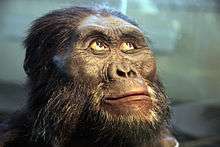
Compared to the modern and extinct great apes, A. afarensis has reduced canines and molars, although they are still relatively larger than in modern humans. A. afarensis also has a relatively small brain size (about 380–430 cm3) and a prognathic face (i.e. a face with forward-projecting jaws).
Skeletal morphology and locomotion
Considerable debate surrounds the locomotor behaviour of A. afarensis. Some studies suggest that A. afarensis was almost exclusively bipedal, while others propose that the creatures were partly arboreal. The anatomy of the hands, feet, and shoulder joints in many ways favour the latter interpretation. In particular, the morphology of the scapula appears to be ape-like and very different from modern humans.[13] The curvature of the finger and toe bones (phalanges) approaches that of modern-day apes, and is suggestive of their ability to efficiently grasp branches and climb. Alternatively, the loss of an abductable great toe and therefore the ability to grasp with the foot (a feature of all other primates) suggests A. afarensis was no longer adapted to climbing.[14]

A number of traits in the A. afarensis skeleton strongly reflect bipedalism, to the extent some researchers have suggested bipedality evolved long before A. afarensis.[15] In overall anatomy, the pelvis is far more human-like than ape-like. The iliac blades are short and wide, the sacrum is wide and positioned directly behind the hip joint, and evidence of a strong attachment for the knee extensors is clear. While the pelvis is not wholly human-like (being markedly wide, or flared, with laterally oriented iliac blades), these features point to a structure that can be considered radically remodeled to accommodate a significant degree of bipedalism in the animals' locomotor repertoire.
Importantly, the femur also angles in toward the knee from the hip. This trait would have allowed the foot to have fallen closer to the midline of the body, and is a strong indication of habitual bipedal locomotion. The feet also feature adducted big toes, making it difficult if not impossible to grasp branches with the hindlimbs. The loss of a grasping hindlimb also increases the risk of an infant being dropped or falling, as primates typically hold onto their mothers while the mother goes about her daily business. Without the second set of grasping limbs, the infant cannot maintain as strong a grip, and likely had to be held with help from the mother. The problem of holding the infant would be multiplied if the mother also had to climb trees. Bones of the foot (such as the calcaneus) also indicate bipedality.[16][17]
Computer simulations using dynamic modeling of the skeleton's inertial properties and kinematics suggest A. afarensis was able to walk in the same way modern humans walk, with a normal erect gait or with bent hips and knees, but could not walk in the same way as chimpanzees. The upright gait would have been much more efficient than the bent knee and hip walking, which would have taken twice as much energy.[18][19]
A. afarensis probably was quite an efficient bipedal walker over short distances, and the spacing of the footprints at Laetoli indicates they were walking at 1.0 m/s or above, which matches human small-town walking speeds.[20] Yet, this can be questioned, as finds of Australopithecus foot bones indicate the Laetoli footprints may not have been made by Australopithecus.[21] Many scientists also doubt the suggestion of bipedalism, and argue that even if Australopithecus really did walk on two legs, it did not walk in the same way as humans.[22][23][24]
The presence of a wrist-locking mechanism, though, might suggest they engaged in knuckle-walking.[25] (However, these conclusions have been questioned on the basis of close analysis of knuckle-walking and the comparison of wrist bones in different species of primates).[26] The shoulder joint is also oriented much more cranially (i.e. towards the skull) than that in modern humans, but similar to that in the present-day apes.[13] Combined with the relatively long arms Au. afarensis is thought to have had, this is thought by many to be reflective of a heightened ability to use the arm above the head in climbing behaviour. Furthermore, scans of the skulls reveal a canal and bony labyrinth morphology, which is not supportive to proper bipedal locomotion.[27]
Upright bipedal walking is commonly thought to have evolved from knuckle-walking with bent legs, in the manner used by chimpanzees and gorillas to move around on the ground, but fossils such as Orrorin tugenensis indicate bipedalism around 5 to 8 million years ago, in the same general period when genetic studies suggest the lineage of chimpanzees and humans diverged. Modern apes and their fossil ancestors show skeletal adaptations to an upright posture used in tree-climbing, and upright, straight-legged walking has been proposed to have originally evolved as an adaptation to tree-dwelling.
Studies of modern orangutans in Sumatra have shown these apes use four legs when walking on large, stable branches and when swinging underneath slightly smaller branches, but are bipedal and maintain their legs very straight when using multiple small, flexible branches under 4 cm in diameter, while also using their arms for balance and additional support. This enables them to get nearer to the edge of the tree canopy to grasp fruit or cross to another tree.
Climate changes around 11 to 10 million years ago affected forests in East and Central Africa, establishing periods where openings in forest lands prevented travel through the tree canopy. During such times proto-hominins could have adopted upright walking behaviour for ever-increasing ground travel, while the ancestors of gorillas and chimpanzees continued to specialize in climbing vertical tree trunks and lianas with a bent-hip and bent-knee posture—which ultimately lead them also to adopt knuckle-walking for minimal ground travel. This differential development within the larger hominid community would result in A. afarensis being adapted to upright bipedalism for extensive ground travel while still using arms well adapted for climbing smaller trees. Still, the proto-hominins and the ancestors of chimpanzees and gorillas were the closest of relatives, and they shared anatomical features including a fused wrist bone, which may suggest that knuckle-walking was used for a time by human ancestors.[28][29][30]
Other studies suggest an upright spine and a primarily vertical body plan in primates dates back to Morotopithecus bishopi in the Early Miocene of 21.6 Mya, the earliest human-like primates.[31][32] Known from fossil remains found in Africa, australopithecines represent the group from which the ancestors of modern humans emerged. As generally used, the term "australopithecine" covers all early hominin fossils dated from about 7 million to 2.5 million years ago—and some others dated later, i.e., from 2.5 million to 1.4 million years ago. Australopithecines became extinct after that time.
Behaviour
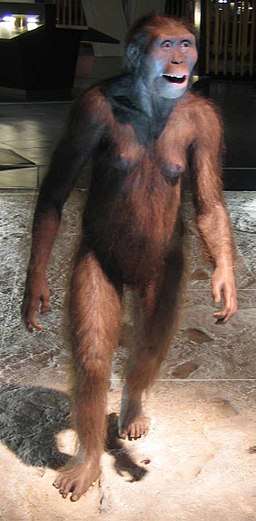
One of the best indicators of social behavior in extinct fossil species are the patterns of the size differences between males and females (sexual dimorphism). By comparisons to the behaviors to modern apes and other animals, reproductive behaviors and social structure in A. afarensis can be inferred. One difficulty is that the average difference in body size between male and female A. afarensis is considerably debated. Some propose that males were substantially larger than females similar to gorillas and orangutans. If observations on the relationship between sexual dimorphism and social group structure from modern gorillas are applied to A. afarensis, then these creatures may have lived in small family groups containing a single dominant male and a number of breeding females.[33] Other studies have shown there could have been substantial overlap between males and females in size more similar to the pattern observed in modern humans.[34] This, along with the reduction of the canine teeth, has been argued to suggest A. afarensis males and females were monogamous.[35] Males may have engaged in provisioning behavior, and the need for carrying may have led to the evolution of bipedalism.
For a long time, no known stone tools were associated with A. afarensis, and paleoanthropologists commonly thought stone artifacts only dated back to about 2.5 Mya.[36] However, a 2010 study suggests the hominin species ate meat by carving animal carcasses with stone implements. This finding pushes back the earliest known use of stone tools among hominins to about 3.4 Mya.[37]
Specimens of A. afarensis
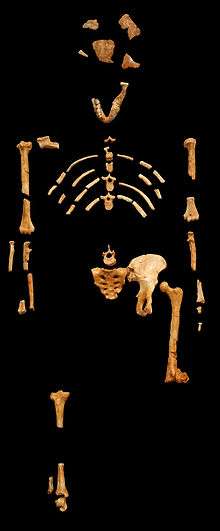
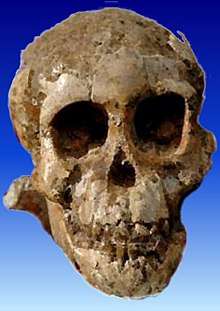
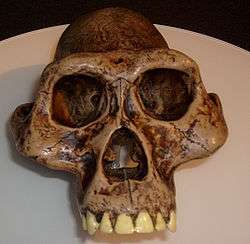
- LH 4
- The type specimen for A. afarensis is an adult mandible from the site of Laetoli, Tanzania.[38]
- AL 129-1
- The first A. afarensis knee joint was discovered in November 1973 by Donald Johanson as part of a team involving Maurice Taieb, Yves Coppens, and Tim White in the Middle Awash of Ethiopia's Afar Depression.
- AL 200-1
- An upper palate with teeth found in October 1974
- AL 288-1 (Lucy)
- The first A. afarensis skeleton was discovered on November 24, 1974 near Hadar in Ethiopia by Tom Gray in the company of Donald Johanson, as part of a team involving Maurice Taieb, Yves Coppens and Tim White in the Middle Awash of Ethiopia's Afar Depression.
- AL 333
- In 1975, a year after the discovery of Lucy, Donald Johanson's team discovered another site in Hadar which included over 200 fossil specimens from at least 13 individuals, both adults and juveniles. This site, AL 333, is commonly referred to as the "First Family". The close alignment of the remains indicates that all the individuals died at the same time, a unique finding.
- AL 333-160
- In February 2011, the discovery of AL 333-160 in Hadar, Ethiopia, at the AL 333 site was announced.[39] The foot bone shows that the species had arches in its feet, which Ward et al. claimed confirmed that the species walked upright for the majority of the time.[40] The foot bone is one of 49 new bones discovered, and indicates that A. afarensis is "a lot more human-like than we had ever supposed before," according to the lead scientist on the study.[41] In a follow-up study by Mitchell et al. that included a more comprehensive sampling than the Ward et al. study, the authors concluded that "Comparisons of the Hadar 4th MT characters to those of statistically representative samples of humans, all five great ape species, baboons and proboscis monkeys show that none of the correlations Ward et al. make to localized foot function were supported by this analysis."[42] They furthermore noted that "Overall, AL 333-160 is most similar to the 4th MT of eastern gorillas, a slow moving quadruped that sacrifices arboreal behaviors for terrestrial ones."
- AL 444-2
- This is the cranium of a male found at Hadar in 1992.[43] By the time it was found, it was the first complete skull of A. afarensis.[44] The rarity of relatively complete craniofacial remains in the A. afarensis samples before the discovery of AL 444-2 seriously hampered prior meaningful analysis of those samples' evolutionary significance. In light of AL 444-2 and other new craniofacial remains, Kimbel, Rak, and Johanson argue in favor of the taxonomic unity of A. afarensis.
- Kadanuumuu
- Also called Big Man, this is a partial skeleton believed to be a male.
- Selam
- In 2000, the skeleton of a 3-year-old A. afarensis female, which comprised almost the entire skull and torso, and most parts of the limbs, was discovered in Dikika, Ethiopia, a few miles from the place where Lucy was found. The features of the skeleton suggested adaptation to walking upright (bipedalism) as well as tree-climbing, features that match the skeletal features of Lucy and fall midway between human and hominid ape anatomy. "Baby Lucy" has officially been named Selam (meaning "peace" in the Amharic/Ethiopian Language).[45]
Related work
 |
Further findings at Afar, including the many hominin bones in site 333, produced more bones of concurrent date, and led to Johanson and White's eventual argument that the Koobi Fora hominins were concurrent with the Afar hominins. In other words, Lucy was not unique in evolving bipedalism and a flat face.
In 2001, Meave Leakey proposed a new genus and species, Kenyanthropus platyops, for fossil cranium KNM WT 40000. The fossil cranium appears to have a flat face, but the remains are heavily fragmented. It has many other characteristics similar to A. afarensis remains. It is so far the only representative of its species and genus, and the timeframe for its existence falls within that of A. afarensis.[46]
Another species, called Ardipithecus ramidus, was found by Tim White and colleagues in 1992. This was fully bipedal at 4.4 to 5.8 Mya, yet appears to have been contemporaneous with a woodland environment. Scientists have a rough estimation of the cranial capacity of Ar. ramidus at 300 to 350 cm³, from the data released on the Ardipithecus specimen nicknamed Ardi in 2009.[47]
See also
- Dawn of Humanity (2015 PBS documentary)
- Life timeline
- List of fossil sites (with link directory)
- List of human evolution fossils (with images)
- Nature timeline
- Origins of Us (2011 BBC documentary)
- Prehistoric Autopsy (2012 BBC documentary)
- The Incredible Human Journey (2009 BBC documentary)
References
- ↑ Johanson, Donald C.; White, Tim D.; Coppens, Yves (1978). "A New Species of the Genus Australopithecus (Primates: Hominidae) from the Pliocene of Eastern Africa". Kirtlandia. 28: 1–14.
- ↑ White, Tim D.; Suwa, Gen; Asfaw, Berhane (1994). "Australopithecus ramidus, a new species of early hominid from Aramis, Ethiopia" (PDF). Nature. 371 (6495): 306–312. Bibcode:1994Natur.371..306W. doi:10.1038/371306a0.
- ↑ Prins, Harald E. L; Walrath, Dana; McBride, Bunny (2007). Evolution And Prehistory: The Human Challenge, by William A. Haviland, Harald E. L. Prins, Dana Walrath, Bunny McBride. ISBN 9780495381907.
- ↑ Greshko, Michael (20 October 2017). "Ancient Teeth Found in Europe Belonged to Mystery Primate". National Geographic. Retrieved 20 October 2017.
- ↑ Wehner, Mike (20 October 2017). "Shocking discovery of ancient teeth could rewrite human history". BGR Media. Retrieved 20 October 2017.
- ↑ Staff (20 October 2017). "9.7 million-year-old teeth fossils discovered in Germany". Daily Sabah. Retrieved 20 October 2017.
- ↑ Cartmill, Matt; Fred H. Smith; Kaye B. Brown (2009). The Human Lineage. Wiley-Blackwell. p. 151. ISBN 978-0-471-21491-5.
- ↑ Cela-Conde, C. J.; Ayala, F. J. (2003). "Genera of the human lineage". Proceedings of the National Academy of Sciences. 100 (13): 7684–7689. Bibcode:2003PNAS..100.7684C. doi:10.1073/pnas.0832372100. PMC 164648. PMID 12794185.
- ↑ Johanson & Maitland 1981, pp. 283–297.
- ↑ Johanson, D.C. (2009). "Lucy (Australopithecus afarensis)". In Michael Ruse; Joseph Travis. Evolution: The First Four Billion Years. Cambridge, Massachusetts: The Belknap Press of Harvard University Press. pp. 693–697. ISBN 978-0-674-03175-3.
- ↑ Wood 1994, p. 234.
- ↑ Reconstruction by John Gurche (2010),Smithsonian Museum of Natural History. Abigail Tucker, "A Closer Look at Evolutionary Faces", Smithsonian.com, February 25, 2010.
- 1 2 Green, D. J.; Alemseged, Z. (2012). "Australopithecus afarensis Scapular Ontogeny, Function, and the Role of Climbing in Human Evolution". Science. 338 (6106): 514–517. Bibcode:2012Sci...338..514G. doi:10.1126/science.1227123. PMID 23112331.
- ↑ Latimer, Bruce; C. Owen Lovejoy (1990). "Hallucal tarsometatarsal joint in Australopithecus afarensis". American Journal of Physical Anthropology. 82 (2): 125–33. doi:10.1002/ajpa.1330820202. PMID 2360609.
- ↑ Lovejoy, C. Owen (1988). "Evolution of Human walking" (PDF). Scientific American. 259 (5): 82–89. Bibcode:1988SciAm.259e.118L. doi:10.1038/scientificamerican1188-118. PMID 3212438.
- ↑ Weiss, M. L.; Mann, A. E. (1985). Human Biology and Behaviour: An anthropological perspective (4th ed.). Boston: Little Brown. ISBN 0-673-39013-6.
- ↑ Latimer, B.; Lovejoy, C. O. (1989). "The calcaneus of Australopithecus afarensis and its implications for the evolution of bipedality". American Journal of Physical Anthropology. 78 (3): 369–386. doi:10.1002/ajpa.1330780306. PMID 2929741.
- ↑ "BBC – Science & Nature – The evolution of man". Mother of man – 3.2 million years ago. Archived from the original on 12 October 2007. Retrieved 2007-11-01.
- ↑ "PREMOG – Research". How Lucy walked. Primate Evolution & Morphology Group (PREMOG), the Department of Human Anatomy and Cell Biology, the School of Biomedical Sciences at the University of Liverpool. 18 May 2007. Archived from the original on 2007-10-25. Retrieved 2007-11-01.
- ↑ "PREMOG – Supplementry Info". The Laetoli Footprint Trail: 3D reconstruction from texture; archiving, and reverse engineering of early hominin gait. Primate Evolution & Morphology Group (PREMOG), the Department of Human Anatomy and Cell Biology, the School of Biomedical Sciences at the University of Liverpool. 18 May 2007. Archived from the original on 2007-07-17. Retrieved 2007-11-01.
- ↑ Wong, Kate (1 August 2005). "Footprints to fill: Flat feet and doubts about the makers of the Laetoli tracks". Scientific American. Retrieved 2010-12-05.
- ↑ Shipman, P. (1994). "Those Ears Were Made For Walking". New Scientist. 143: 26–29.
- ↑ Susman, R. L; Susman, J. T (1983). "The Locomotor Anatomy of Australopithecus Afarensis". American Journal of Physical Anthropology. 60 (3): 279–317. doi:10.1002/ajpa.1330600302. PMID 6405621.
- ↑ Beardsley, T. (1995). "These Feet Were Made for Walking – and?". Scientific American. 273 (6): 19–20. Bibcode:1995SciAm.273f..19B. doi:10.1038/scientificamerican1295-19a.
- ↑ Richmond, B. G.; Begun, D. R.; Strait, D. S. (2001). "Origin of human bipedalism: The knuckle-walking hypothesis revisited". Am. J. Phys. Anthropol. Suppl. 33: 70–105. doi:10.1002/ajpa.10019. PMID 11786992.
- ↑ Kivell, T. L.; Schmitt, D. (2009). "Independent evolution of knuckle-walking in African apes shows that humans did not evolve from a knuckle-walking ancestor". Proc. Natl. Acad. Sci. U.S.A. 106 (34): 14241–6. Bibcode:2009PNAS..10614241K. doi:10.1073/pnas.0901280106. PMC 2732797. PMID 19667206.
- ↑ Zonneveld, F.; Wood, F.; Zonneveld, B. (1994). "Implications of early hominid morphology for evolution of human bipedal locomotion". Nature. 369 (6482): 645–648. Bibcode:1994Natur.369..645S. doi:10.1038/369645a0. PMID 8208290.
- ↑ Ian Sample, science correspondent (June 1, 2007). "New theory rejects popular view of man's evolution – Research – EducationGuardian.co.uk". The Guardian. London. Archived from the original on 24 November 2007. Retrieved 2007-11-05.
- ↑ "BBC NEWS – Science/Nature – Upright walking 'began in trees'". BBC News. 31 May 2007. Archived from the original on 9 October 2007. Retrieved 2007-11-05.
- ↑ Thorpe S.K.S.; Holder R.L.; Crompton R.H. (24 May 2007). "PREMOG – Supplementry Info". Origin of Human Bipedalism As an Adaptation for Locomotion on Flexible Branches. Primate Evolution & Morphology Group (PREMOG), the Department of Human Anatomy and Cell Biology, the School of Biomedical Sciences at the University of Liverpool. Archived from the original on 2007-07-17. Retrieved 2007-11-01.
- ↑ Aaron G. Filler (December 24, 2007). "Redefining the word "Human" – Do Some Apes Have Human Ancestors? : OUPblog". Archived from the original on 29 December 2007. Retrieved 2007-12-27.
- ↑ Aaron G. Filler (October 10, 2007). "PLoS ONE: Homeotic Evolution in the Mammalia: Diversification of Therian Axial Seriation and the Morphogenetic Basis of Human Origins". Archived from the original on 27 December 2007. Retrieved 2007-12-27.
- ↑ Wood 1994, p. 239.
- ↑ Reno, Philip L.; Lovejoy, C. Owen (2015-04-28). "From Lucy to Kadanuumuu: balanced analyses of Australopithecus afarensis assemblages confirm only moderate skeletal dimorphism". PeerJ. 3. doi:10.7717/peerj.925. ISSN 2167-8359. PMC 4419524. PMID 25945314.
- ↑ Lovejoy, C. Owen (2009-10-02). "Reexamining human origins in light of Ardipithecus ramidus". Science. 326 (5949): 74e1–8. Bibcode:2009Sci...326...74L. doi:10.1126/science.1175834. ISSN 1095-9203. PMID 19810200.
- ↑ Jones, S.; Martin, R.; Pilbeam, D., eds. (1994). The Cambridge Encyclopedia of Human Evolution. Cambridge: Cambridge University Press. ISBN 978-0-521-32370-3. Also ISBN 0-521-46786-1 (paperback)
- ↑ McPherron, Shannon P.; Zeresenay Alemseged; Curtis W. Marean; Jonathan G. Wynn; Denne Reed; Denis Geraads; Rene Bobe; Hamdallah A. Bearat (2010). "Evidence for stone-tool-assisted consumption of animal tissues before 3.39 million years ago at Dikika, Ethiopia". Nature. 466 (7308): 857–860. Bibcode:2010Natur.466..857M. doi:10.1038/nature09248. PMID 20703305.
- ↑ Larry L Mai; Marcus Young Owl; M Patricia Kersting (2005). The Cambridge Dictionary of Human Biology and Evolution. Cambridge & New York: Cambridge University Press. p. 45. ISBN 978-0-521-66486-8.
- ↑ Ward, C. V.; Kimbel, W. H.; Johanson, D. C. (2011). "Complete Fourth Metatarsal and Arches in the Foot of Australopithecus afarensis". Science. 331 (6018): 750–3. Bibcode:2011Sci...331..750W. doi:10.1126/science.1201463. PMID 21311018.
- ↑ Amos, Johnathan (10 February 2011). "Fossil find puts 'Lucy' story on firm footing". BBC News. BBC Online. Archived from the original on 13 February 2011. Retrieved 13 February 2011.
- ↑ Silvey, Janese (10 February 2011). "Fossil marks big step in evolution science". The Columbia Daily Tribune. Archived from the original on 14 February 2011. Retrieved 13 February 2011.
- ↑ Mitchell, P. J.; Sarmiento, E. E.; Meldrum, B. J. (2012). "The AL 333-160 fourth metatarsal from Hadar compared to that of humans, great apes, baboons and proboscis monkeys: Non-conclusive evidence for pedal arches or obligate bipedality in Hadar hominins". HOMO - Journal of Comparative Human Biology. 63 (5): 336–67. doi:10.1016/j.jchb.2012.08.001. PMID 22995931.
- ↑ Nancy Minugh-Purvis (May 2005). "Review of "The Skull Of Australopithecus afarensis" by William H. Kimbel, Yoel Rak and Donald C. Johanson" (PDF).
- ↑ "Description of "The Skull Of Australopithecus afarensis" by William H. Kimbel, Yoel Rak and Donald C. Johanson".
- ↑ Wong, Kate (2006-09-20). "Lucy's Baby: An extraordinary new human fossil comes to light". Scientific American.
- ↑ Leakey, M. G., et al (2001). New hominin genus from eastern Africa shows diverse middle Pliocene lineages, Nature, Volume 410, pgs. 433-440
- ↑ Suwa, G; Asfaw, B.; Kono, R. T.; Kubo, D.; Lovejoy, C. O.; White, T. D.; et al. (2 October 2009). "The Ardipithecus ramidus skull and its implications for hominid origins". Science. 326 (5949): 68, 68e1–68e7. Bibcode:2009Sci...326...68S. doi:10.1126/science.1175825. PMID 19810194.
Further reading
- Mckie, Robin (2000). BBC – Dawn of Man: The Story of Human Evolution. Dorling Kindersley. ISBN 0-7894-6262-1.
- Barraclough, G. (1989). Stone, N., ed. Atlas of World History (3rd ed.). Times Books Limited. ISBN 0-7230-0304-1.
- Australopithecus afarensis from The Human Origins Program at the Smithsonian Institution
- Delson, E.; I. Tattersall; J.A. Van Couvering; A.S. Brooks, eds. (2000). Encyclopedia of human evolution and prehistory (2nd ed.). Garland Publishing, New York. ISBN 0-8153-1696-8.
- Johanson, D.C.; Maitland, A.E. (1981). Lucy: The Beginning of Humankind. St Albans: Granada. ISBN 0-586-08437-1.
- Wood, B.A. (1994). "Evolution of australopithecines". In Jones, S.; Martin, R.; Pilbeam, D. The Cambridge Encyclopedia of Human Evolution. Cambridge, U.K.: Cambridge University Press. ISBN 978-0-521-32370-3. Also ISBN 0-521-46786-1 (paperback).
External links
| Wikimedia Commons has media related to Australopithecus afarensis. |
- Asa Issie, Aramis and the origin of Australopithecus
- Lucy at the American Museum of Natural History in Manhattan
- Lucy at the Institute of Human Origins at Arizona State University
- Asfarensis
- Anthropological skulls and reconstructions
- Becoming Human: Paleoanthropology, Evolution and Human Origins
- National Geographic "Dikika baby"
- MNSU
- Archaeology Info
- Australopithecus afarensis – The Smithsonian Institution's Human Origins Program
- Washington State University – Australopithicus afarensis: The story of Lucy
- Australopithecus afarensis - Science Journal Article
- Human Timeline (Interactive) – Smithsonian, National Museum of Natural History (August 2016).